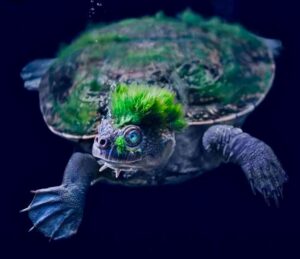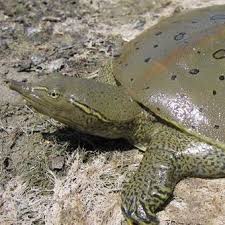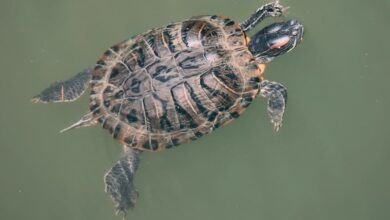Small Amounts of Algae On Your Turtle
If you have a turtle as a pet and keep it in a tank, you probably see algae developing on its shell. While this is a standard process in wild turtles, it is not always suitable for your pet turtle.
You may get rid of the algae on your turtle in a variety of methods. Cleaning your turtle is an essential aspect of having one.
You may not feel it necessary to clean the tanks if you change their water regularly. But there are several conditions that your turtle will develop algae if you do not clean them regularly.
Symptoms and Causes
A fungal infection on your turtle’s skin may appear as fuzzy white or grey spots. Flaking, peeling, blisters, or the appearance of cheese-like material on his skin are some of the other signs.
Normal skin shedding does not produce redness, white patches, or swelling. Poor water quality or an insufficient basking space are common causes of skin fungus.

What should you do if you notice algae on your turtle?
Skin fungus can affect aquatic turtles. The fungus can prove deadly if left untreated. It’s natural for algae to develop on a turtle’s shell. Most wild turtle “carapaces” have algae growing on them.
You cannot ignore the algae on the shell completely. It may be hiding anything as a result of a previous infection or disease. Examine your aquatic turtle’s skin for indications of skin fungus regularly. If you suspect skin fungus or other health problems in your turtle, consult a veterinarian who specializes in turtles.
Removing Algae from Your Turtle
Following are some of the methods to reduce algae from your turtle.
- Using a filter
Algae require both sunshine and nutrition to thrive, and if you deprive them both, they will either die or certainly reduce. Keeping the water flowing using a filter or aerator will also help, as it is difficult for algae to grow in this environment.
- Turtle Soak and Topical Treatment
Remove your sick turtle from his tank and carefully clean his shell with a gentle toothbrush while washing him in warm water.
Soak your pet in just enough solution to cover his shell for 15 minutes every day until the fungus is completely gone. Allow your turtle to dry completely before applying a tiny amount of betadine-containing antibiotic ointment to the fungal regions.
- Salt Baths
If you detect the fungus early enough, a few salt baths may be all your turtle needs. At 80 degrees Fahrenheit, make a solution of 2 teaspoons of salt in a gallon of water. Soak your pet for 15 minutes, barely covering his shell, once or twice every day for four or five days. After his soak, let him dry thoroughly, but do not keep him out of his tank for more than two hours.
- Treating the Infected Tank
Clean and disinfect your turtle’s tank and all its accessories with a solution of 1 part chlorine to 100 parts water before returning it to its tank. Allow everything to dry completely after a thorough rinse. Before you set up the tank, replace the substrate. Change the water every day for the duration of the treatment.
- Some Other Steps for Removing Algae
To keep your aquatic turtle from getting skin fungus, follow a few simple steps. Supplement your turtle’s diet with vitamin C. Feed him in a separate, smaller tank to avoid food contamination in his main tank.
Use a UVB lamp or natural sunshine to provide 12 hours of light each day. Provide a large enough basking area for your turtle to get entirely out of the water, and use the appropriate water temperature for the turtle’s species.





